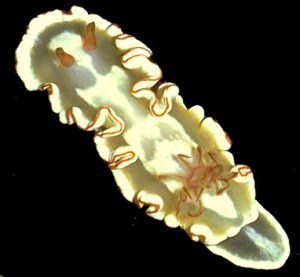
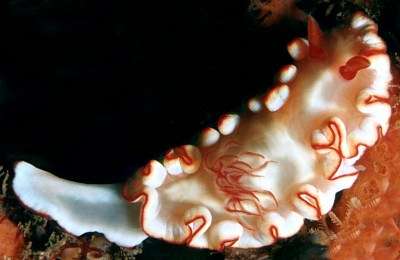
Glossodoris symmetricus
Rudman, 1990
Order: NUDIBRANCHIA
Suborder: DORIDINA
Superfamily: EUDORIDOIDEA
Family: Chromodorididae
DISTRIBUTION
Indo-West Pacific.
PHOTO
UPPER: Holotype. St.Gilles Reef, Reunion Is. Indian Ocean. 19mm long preserved. PHOTO: M. Jay.
LOWER: Scottburgh, South coast KwaZulu-Natal, SOUTH AFRICA. 25m, March 2000. Size: 45mm. PHOTO: Valda Fraser.
This species has a symmetrical opaque white marking on the mantle, similar to that found on Glossodoris pallida. It differs from G. pallida in having an orange-red mantle border (yellow in G. pallida) and similar colour differences on the rhinophores and gills.
Reference:
• Rudman, W.B. (1990) The Chromodorididae (Opisthobranchia: Mollusca) of the Indo-West Pacific: further species of Glossodoris, Thorunna and the Chromodoris aureomarginata colour group. Zoological Journal of the Linnean Society, 100(3): 263-326.
Rudman, W.B., 2000 (April 25) Glossodoris symmetricus Rudman, 1990. [In] Sea Slug Forum. Australian Museum, Sydney. Available from http://www.seaslugforum.net/find/glossymm
Related messages
Glossodoris cf. symmetricus feeding in Mayotte Island
March 11, 2010
From: Matthias Deuss
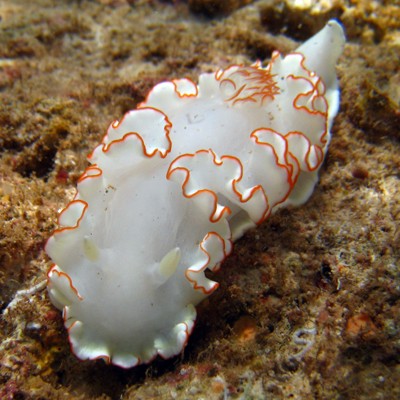
Dear Bill,
since Christmas my friends and I spotted at least two specimens of this nudibranch. Do you still consider it is a white-rhinophore variant of Glossodoris symmetricus ?
Locality: Mbouini beach, Mayotte Island, Comoros, Indian Ocean, 21 December 2009, Intertidal and muddy. Photographer: Matthias Deuss.
This one was feeding on a purple sponge under a rock. You can see a tiny bit of purple material between its gills. As we turned the rock over we saw the sponge floating : it had been torn away from its substrate. Then, having noticed the tiny speck of purple in the gills, I put the sponge in front of the slug, which hurried upon it.
I hope this information will be useful.
Regards,
Matthias Deuss
matthias976@hotmail.fr
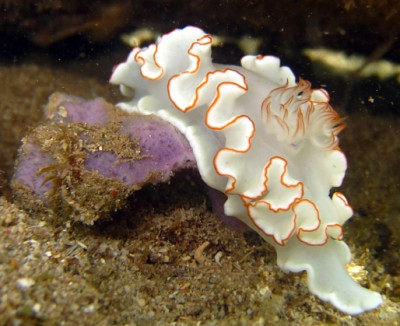

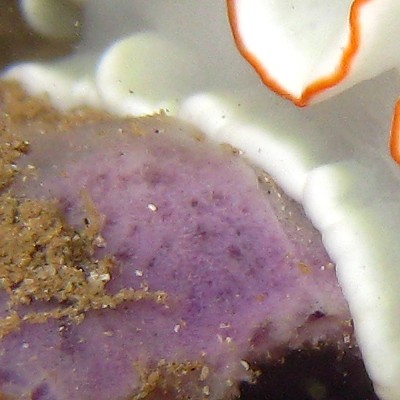
Dear Matthias,
Thanks for this interesting information. As far as the identity of the animal goes, I can't be 100% sure if these animals with white or colourless rhinophores [see #15447 from Tanzania; #22817 from Mozambique] but I think they are. However, as I have mentioned before white chromodorids with an orange and yellow border can sometimes be full of surprises when you look at their anatomy.
The purple speck by the gills could well be waste from the anal papillae but looking at your close-up of the sponge has me puzzled. It doesn't look like any sponge a Glossodoris 'should' eat so I will have to get some help to identify it.
Best wishes,
Bill Rudman
Re: Glossodoris symmetricus
November 19, 2009
From: Valda Fraser
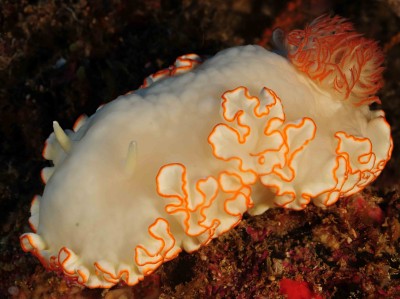
Dear Bill
I'm not sure whether this critter is in fact Glossodoris symmetricus. The markings do not seem 100% right, also, the enormous size. Words of wisdom please.
Locality: Pomene, 32 m, Mozambique, Indian Ocean, 13 November 2009, rocky reef. Length: 150 mm. Photographer: Valda Fraser.
All the best
Valda
valdafraser@mweb.co.za
Fraser, V.J., 2009 (Nov 19) Re: Glossodoris symmetricus. [Message in] Sea Slug Forum. Australian Museum, Sydney. Available from http://www.seaslugforum.net/find/22817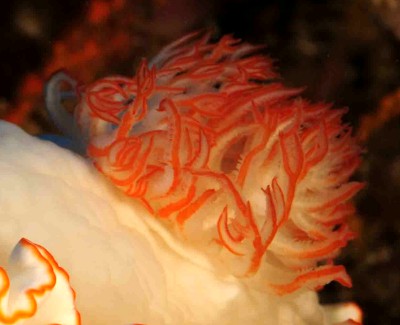
Dear Valda,
I agree that it's very large. I can't really say without dissection whether it is G. symmetricus because it lacks the characteristic white pattern on its back and the gills are branched. However both these differences, like its folded mantle edge, may well be related to it large size. I think I will tentatively identify it with that species until we know more.
Best wishes,
Bill Rudman
Glossodoris symmetricus from the Solomons
September 26, 2007
From: N.Barbara Hanchard
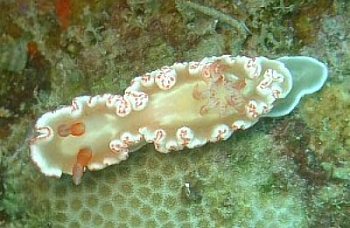
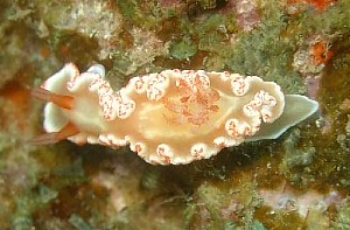
Bill,
Find attached 3 photos of what I think is something that Coleman identifies in his 1001 book as a "pink gilled glossodoris", as having been found in neighbouring Papua New Guinea and which he claims as, 'undescribed' to date. I haven't done a search to see if the animal is further researched but I am sure you will know. While the photos appear pale orange, the animal was actually a very lovely pale pink, including the rhinophores and mantle trim.
Locality: Boneghi Two Wreck, Guadacanal, 6 - 7 meters, Solomon Islands, Pacific Ocean, 23 September 2007, Wreck. Length: 35 mm. Photographer: N. Barbara Hanchard.
Grateful for your opinion.
Regards
Barbara Hanchard
barbara.hanchard@ffa.int
Hanchard, N.B., 2007 (Sep 26) Glossodoris symmetricus from the Solomons. [Message in] Sea Slug Forum. Australian Museum, Sydney. Available from http://www.seaslugforum.net/find/20803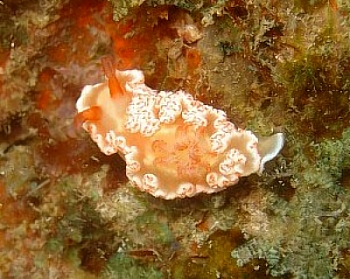
Dear Barbara,
This is Glossodoris symmetricus, which was described some 10 years before Neville's book. It has mainly been reported from the western Indian Ocean. I know of a few previous reports from the western Pacific [Papua New Guinea, Marshall Islands] so your records from the Solomons are a valuable addition to our knowledge.
Best wishes,
Bill Rudman
Re: Glossodoris symmetricus from the Red Sea
January 12, 2006
From: Andrej Jaklin
Concerning message #15503.
Dear Bill and Binyamin,
What an interesting problem regarding colour at depth. From my own experience I know that a diver, familiar with particular object, usually thinks that he can see different colours, regardless actual depth. Especially with very good visibility and lot of light.
Maybe the quickest way to check what happened here is to get another photo of the same species only in available light. If there is really a bioproduction of light, the red mantle border will pop-up from dull grayish rest of the picture.
Best regards,
aj
jaklin@cim.irb.hr
Jaklin, A., 2006 (Jan 12) Re: Glossodoris symmetricus from the Red Sea. [Message in] Sea Slug Forum. Australian Museum, Sydney. Available from http://www.seaslugforum.net/find/15516Thanks Andrej,
Bill Rudman
Glossodoris symmetricus from the Red Sea
January 10, 2006
From: Binyamin Koretz
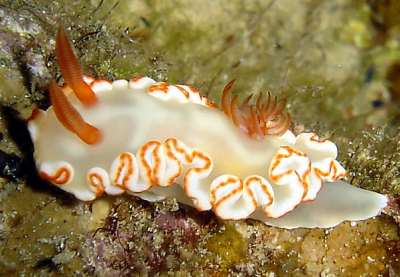
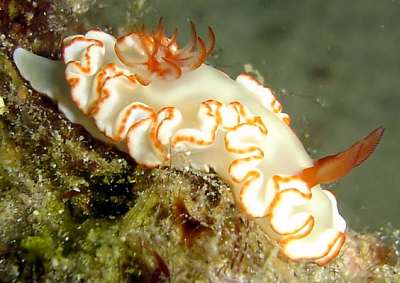
Dear Bill,
Hope you've had a good holiday season.
We had two questions regarding Glossodoris symmetricus:
1. Why symmetricus and not symmetrica?
2. In your study of the animal, did you find that the red color is something like fluorescent? We encountered it at 32 m and both of us said after the dive that we could see the red color in the deep without artificial light, unlike other chromodorids with red or orange color where the color looks gray to brown in available light.
Locality: Eilat, Yatush Area, Israel. Red Sea (Gulf of Eilat). Depth: 32 m. Length: 2.2 cm. 16 December 2005. corals. Photographer: Binyamin and Shulamit Koretz
with best wishes for the New Year
Regards
Binyamin Koretz
binyamin@koretz.net
Koretz, B., 2006 (Jan 10) Glossodoris symmetricus from the Red Sea. [Message in] Sea Slug Forum. Australian Museum, Sydney. Available from http://www.seaslugforum.net/find/15503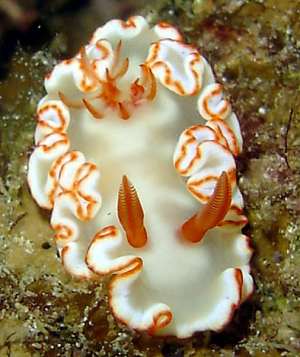
Dear Binyamin,
Thanks for the New Year's greetings. It was 45º C here on January 1 - I hope that was an aberration and not a sign of things to come!
Thanks for the nice photos of G. symmetricus. You ask a couple of interesting questions. Concerning symmetricus versus symmetrica. I am not a Latin scholar and used to check my names with a colleague who was. However you may be right. I will check it out.
Concerning the colour. I have never seen this species alive - only from specimens and colour photos. If you did see red it would suggest the animal- or something in it - is perhaps producing red light - a very unusual phenomenon, which would be worth following up if you get the opportunity.
Best wishes,
Bill Rudman
Re: Glossodoris symmetricus from Mikindani, Tanzania
December 16, 2005
From: Claus Gregersen
Thank you very much for your reply [message #15447 ]. I've attached a photo with a much higher resolution for your files.
Locality: CryptoMania, Mikindani Bay, Mtwara Province, Tanzania. Indian Ocean. Depth: 10-12 metres. Length: 10-11 cm.16 November 2005. Intertidal, sandy slope. Photographer: Lene Kim Slengerich
Best wishes
Claus
e-mail@kofte.dk
Gregersen, Claus, 2005 (Dec 16) Re: Glossodoris symmetricus from Mikindani, Tanzania. [Message in] Sea Slug Forum. Australian Museum, Sydney. Available from http://www.seaslugforum.net/find/15473Dear Claus,
Thanks for this higher resolution photo. Apart from the rhinophore colour - or lack of it - I am pretty sure this is G. symmetricus. I have a little hesitation though, because almost every time I dissect a chromodorid of this colour pattern - white with orange or yellow mantle edge - but with slight differences from existing species I find something different. But at this stage we know too little about colour variability in this species
Best wishes,
Bill Rudman
Glossodoris symmetricus from Mikindani, Tanzania
December 12, 2005
From: Claus Gregersen
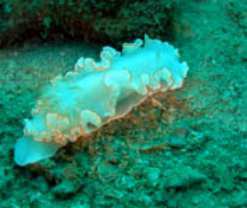
Dear Sirs
I have in vain tried to identify the attached slug. Perhabs a Glossodoris symmetricus - but "my" specimen has orange-red mantle border, white rhinophores, and what seems like orange-red gill-border?
Locality: CryptoMania, Mikindani Bay, Mtwara Province, Tanzania. Indian Ocean. Depth: 10-12 metres. Length: 10-11 cm. 16 November 2005. Intertidal, sandy slope. Photographer: Lene Kim Slengerich
Could you be of assistance?
Best
Claus Gregersen
Denmark
e-mail@kofte.dk
Gregersen, Claus, 2005 (Dec 12) Glossodoris symmetricus from Mikindani, Tanzania. [Message in] Sea Slug Forum. Australian Museum, Sydney. Available from http://www.seaslugforum.net/find/15447Dear Claus,
It's a bit hard to be sure with such a small photo but I think you are probably correct in thinking it is G. symmetricus. It's only known from the western Indian Ocean so the locality is ok. I suspect the lack of colour in the rhinophores may be a variation we don't know about. The orange-red rhinophore colour doesn't seem to be a heavy pigmentation in any of the specimens I have seen
Best wishes,
Bill Rudman
Glossodoris symmetricus from the Egyptian Red Sea?
December 2, 2005
From: Joseph De Vroe
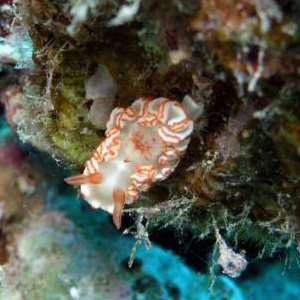
Hi Bill,
My congratulations for your website.
Last year I took a picture of a for me unknown Glossodoris. Some people told me that it was a Glossodoris symmetricus. Can you confirm this ? Your factsheet doesn't mention the Red Sea as distribution ?
Locality: Ras Abu Nugar (El Gouna), Egypt, Red Sea. Depth: 08 m. Length: 10 mm. 30 Juli 2004. Photographer: Joe De Vroe
Kind regards and thanks for your comments,
Joe
joe.devroe@skynet.be
De Vroe, J., 2005 (Dec 2) Glossodoris symmetricus from the Egyptian Red Sea?. [Message in] Sea Slug Forum. Australian Museum, Sydney. Available from http://www.seaslugforum.net/find/15373Dear Joe,
Yes this is G. symmetricus. Although I don't specifically say 'Red Sea' in the 'Distribution', the term 'Indo-West Pacific' is a general term to cover the tropical and sub-tropical Indian Ocean and West Pacific Ocean regions. I have seen animals from Reunion Island, Papua New Guinea and the Marshall Islands, and we have records on the Forum from South Africa, so we can be fairly confident it will be found in other parts of this vast biogeographic region as well. The Red Sea is a good start in filling the gaps.
Best wishes,
Bill Rudman
Glossodoris symmetricus in Reunion Island
February 18, 2005
From: Philibert Bidgrain
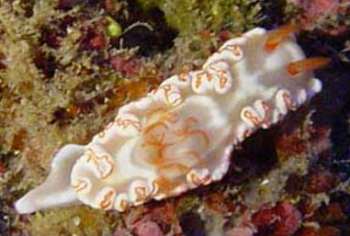
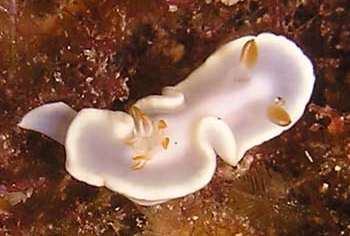
Dear Bill,
Reunion Island sea slugs:
Glossodoris symmetricus is relatively common in Reunion Island. I send you two photos The upper one was found by Florence Trentin at Saint Leu, the lower one was also found by Florence Trentin : Dive site " Maison verte" at Saint Leu, 18 m, 16 December 2004, size 15 mm, may be it's a juvenile form....
Locality: Saint Leu, Reunion Island, Indian Ocean, Photographer: Florence Trentin.
Best Regards
Philibert Bidgrain
http://vieoceane.free.fr/runseaslug/indexslug.htm
pbidgrain@yahoo.fr
Bidgrain, P., 2005 (Feb 18) Glossodoris symmetricus in Reunion Island. [Message in] Sea Slug Forum. Australian Museum, Sydney. Available from http://www.seaslugforum.net/find/12984Dear Philibert,
I think you are probably correct in thinking the lower photo is a juvenile. There is a slight chance it is a different species, perhaps a Noumea, but I have seen small specimens of this species without the ruffled edge to the mantle. If it is not uncommon it might be worth checking out a population of them. See if you can find colour and shape variation in the species - or perhaps consistent differences between the two forms.
Best wishes,
Bill Rudman
Glossodoris from South Africa
January 7, 2001
From: Valda Fraser
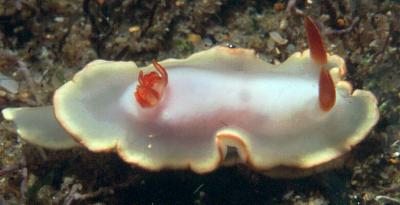
Dear Bill
I am unable to identify this white Glossodoris looking nudibranch edged with yellow and red. Can you help?
Locality: Sodwana, north coast KwaZulu-Natal, SOUTH AFRICA, 15m
Date: Nov 2000
Size: 15mm
Regards
Valda Fraser
valdafraser@mweb.co.za
Fraser, V., 2001 (Jan 7) Glossodoris from South Africa. [Message in] Sea Slug Forum. Australian Museum, Sydney. Available from http://www.seaslugforum.net/find/3327Dear Valda,
I am pretty sure this is a juvenile of Glossodoris symmetricus. Often these species with very folded mantle edges only develop the folds as the animal grows. Similarly the characteristic opaque white patch on the dorsum develops with age.
Best wishes,
Bill Rudman
Glossodoris symmetricus from South Africa
April 26, 2000
From: Valda Fraser

Dear Bill
This nudibranch is common in certain areas. Please confirm that it is Glossodoris symmetricus.
Thank you.
Locality: South coast KwaZulu-Natal, SOUTH AFRICA. Scottburgh - 25m
Date: March 2000
Size: 45mm
Regards
Valda Fraser
iti04937@mweb.co.za
Fraser, V., 2000 (Apr 26) Glossodoris symmetricus from South Africa. [Message in] Sea Slug Forum. Australian Museum, Sydney. Available from http://www.seaslugforum.net/find/2263Dear Valda,
At first I thought this was another unnamed species from South Africa because the way it is photographed does not make the opaque white marking on the mantle very obvious. But after looking at the photo again I am pretty sure it is Glossodoris symmetricus. I named this species G. 'symmetricus' because of the symmetrical white marking which can be clearly seen in the photo at the Top of the page. It is certainly a striking animal.
Best wishes,
Bill Rudman.
